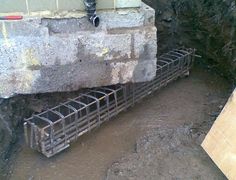Underpinning is the practice of expanding an existing structure’s foundation so it rests more securely on more supportive soil strata or spreads its load more evenly across a larger area. Micro piling and jet grouting are popular underpinning methods used today.
Underpinning must be performed carefully and gradually in order to preserve the structural integrity of an existing building, by excavating soil in controlled sections known as pins.
Needle Method
Underpinning Melbourne using this technique involves installing a concrete needle beam onto piles that can either be cast in-situ or precast; ideal for areas where access to existing foundations is limited.
This method is cost-effective and ideal for shallow foundations. In it, existing load is transferred onto new pin with help of a dry sand-cement pack placed between existing and new foundation.
As soon as two micropiles have been laid at a distance from an existing wall using a micropiling rig, two needle beams made out of RCC are then constructed over them and installed within existing foundation walls. When complete, fill in earth around them. This method has the added advantage of not disturbing existing building structures while being quick and nondisruptive – perfect for situations when existing foundation rests on poor soil strata that needs deepening to support heavier loads.
Pile Method
Piling has a rich and long-standing history dating back millennia. As one of the earliest forms of underpinning, this technique uses piles to redistribute weight evenly across an underpinned structure so it rests more securely on more stable soils.
Underpinning is often coupled with anti-heave measures to ensure a building doesn’t heave after the work has been completed. To do this, a beam of concrete may be placed above, below, or to replace an existing foundation and redirecting load onto multiple piles to ensure no heaving takes place.
Pile underpinning can be employed when an existing foundation rests on soil with limited bearing capacity, and must be transferred to deeper strata for stability and environmental pollution control. Pile material typically comprises steel or concrete piles which are driven or bored into position depending on project requirements; they may even include mixed materials.
Mass Pour Method
Underpinning is a construction technique used to reinforce or strengthen the foundation of a house, building or structure in order to allow it to withstand heavier loads. This may be accomplished through adding filler material or increasing depth and breadth of foundation – or more frequently both approaches combined together.
Mass concrete underpinning has been around for centuries. The practice involves excavating soil under existing foundations until an acceptable layer has been reached, then pouring concrete in stages progressively increasing depth of underpinning with each pour until finally filling back in again with earth.
Subsidence can often be addressed effectively using this approach; however, this should only be seen as a temporary fix and other techniques should also be taken into consideration. Perforated pipes inserted beneath an existing foundation and filled with sodium silicate should help consolidate soil more quickly so as to be resistant to heaving and frost heave.
Beam Method
Underpinning buildings with shallow foundations requires using this underpinning method: A beam made of reinforced concrete is installed below existing foundation to transfer its load onto stronger soil stratum. It provides an effective and practical solution.
This underpinning method, also known as pier and beam or needle beam on micro piers, was developed as an alternative to the pit method due to its ineffectiveness at supporting deep foundations. Reinforced concrete beams are placed over each pier before filling them up with mass concrete to distribute loads evenly across them.
Underpinning is an emerging technology that involves hardening soil rather than building new foundations to support them. While requiring specialist equipment for use, this method can often be much faster than other forms of underpinning.
